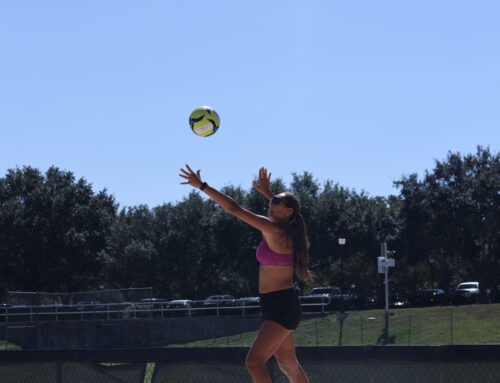There is a rule experiment coming to beach volleyball. Two of them, in fact, beginning with the Gstaad Elite on the first weekend of July. The final event of the experimental phase will be the Hamburg Elite, and sandwiched in between the two is the Montreal Elite.
The first, and most-discussed, even with it still being a month out of being tried, is the removal of doubles on the second contact. The second change is an interesting addendum in which coaches will now be allowed in the boxes with the players, able to communicate with them on side switches and timeouts.
The most pressing of the two, of course, is the doubles.
Players can now do virtually whatever they want on the second contact. One-handed flick? Chuck it sideways? Toss some topspin, backspin, sidespin on there and fling it? All good. So long as it comes out fast, so as not to be a lift, it’s clean. They still cannot take the first contact with their hands, unless it comes out clean — shout out to Kusti Nolvak for being one of the only players to successfully pull that off.
This isn’t the first time the FIVB and Beach Volleyball World have proposed changes that transition the beach game to look more like its indoor counterpart. In January of 2018, at a four-star tournament in The Hague, Netherlands – a tournament, coincidentally, played indoors – the FIVB experimented with allowing four touches off the block, like indoor.
It lasted a single tournament before players shot it down.
A credit must be given to the FIVB in that it listened to the players then. It’s an organization that routinely experiments with changes to, in their mind, elevate the level of play. I could see how allowing that extra touch off the block could, in theory, have created a higher-level play than, say, lobbing a free ball over, which is common on plays in which a soft block has happened. But theory often doesn’t translate to reality, and in this case, it didn’t. It was removed before the next event, the Fort Lauderdale Major.
I’d expect something similar with the doubles.
If the argument from the FIVB is that the change will elevate the level of play, I don’t quite see how it would, in any way, accomplish that mission. If anything, it simply reduces the skill required to set an out of system ball, or to set a ball well at all. It is, as Stefan Boermans says on this week’s podcast, “taking away the beauty of the game.”
But, again, I think this will be an ephemeral experiment. I have yet to hear a single player or fan or official in favor of it.
I do not think it will last, and when it’s all said and done, it will be reviewed as a silly test that went how virtually everyone expected it to, no different than the Hague’s four-touch trial.
The coaches in the box, however, might be different.
If the goal is to elevate the level of play, this, I think, would accomplish that. Coaches can see things players can’t and vice versa. The strategy shifts and tactical adjustments would be made quicker. The impact would be visible but not overwhelmingly so; coaches, after all, cannot pass or set or serve or side out. They’re just there to add a thought or two, steady out some emotional swings, and be a voice of reason when partners are squabbling.
I’m intrigued by it.
I get the other side of the argument as well, one Boermans presents in the podcast on Wednesday. He views the chess match and adjustments as a skill for players. My wife, Delaney, has the same view, and it was a point of pride of mine in my own limited skillset as a player. I loved the chess match, which is why I love being a coach.
If it sticks, I think it could be a good thing, as now coaches, typically anonymous, shadowy figures at the professional level, get a little more visibility, and the game could indeed be elevated. If it doesn’t, I get that, too: the chess match and mental side is an aspect of the skill set required of a player.
The rules, then, come down to one question: Do we want more skilled beach volleyball teams, or less?
Come September, we’ll know the answer.


